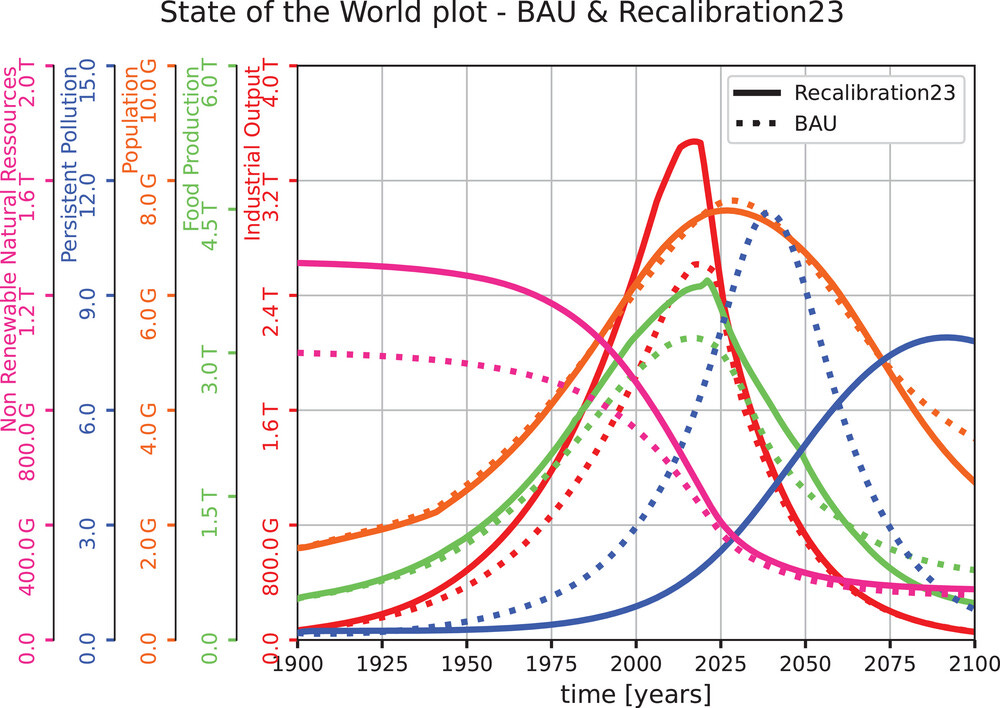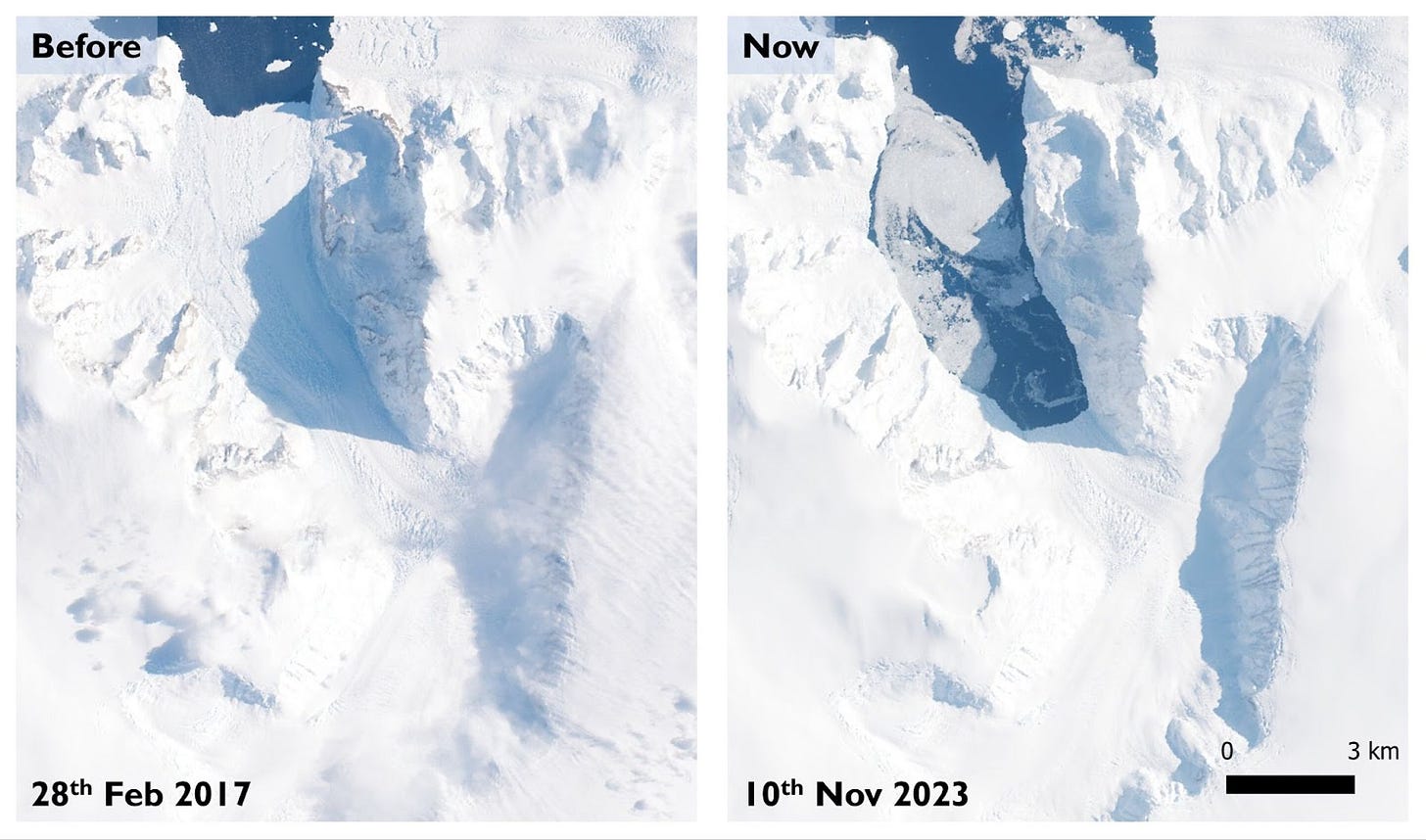Last Week in Collapse: November 26-December 2, 2023
Flooding in East Africa, a tsunami in the Philippines, and a climate conference in a petro-state.
Last Week in Collapse: November 26-December 2, 2023
This is Last Week in Collapse, a weekly newsletter bringing together some of the most important, timely, useful, soul-crushing, ironic, astounding, or otherwise must-see/can’t-look-away moments in Collapse.
This is the 101st newsletter. You can find the November 19-25 edition here on Reddit if you missed it last week. Thank you for subscribing to the Substack.
We are now in the final month of 2023, and the UN is predicting that this year will be the hottest on record. The World Meteorological Organization released its 35-page Provisional State of the Global Climate, 2023 report on the first day of COPout28. Its findings are not hopeful: the ocean has hit record warmth, glaciers are experiencing an “extreme melt season,” climate change has displaced millions, and the past 9 years have been the hottest 9 on record. Sea level has also risen over 1 centimeter in the last 30 years.
India is supposedly planning on tripling its underground coal production by 2028. (Currently India sources about 5% of its coal from such mines.) The world’s most populous nation is planning on a sustained period of growth and is struggling to produce the energy necessary to deliver it.
An Emirati oil sheikh has been buying up huge tracts of African forests as part of a carbon offset scheme for the young company, Blue Carbon. The total acreage of their holdings is unclear, but it is greater than Japan’s largest island, Honshū.
Saudi Arabia is reportedly trying to create more dependencies on Saudi oil & gas among the “poor countries” of the world. Their Oil Demand Sustainability Programme (ODSP) aims at increasing the number of power ships, buses, and planes used by the Global South, and replacing wood stoves with gas stoves. Critics say this is a plot to boost oil use and Saudi revenues while the world struggles to make the switch to renewables. But what do the recipients think?
Damage report from East Africa, where “once-in-a-century” flooding has hit hard: 70+ dead in Kenya and another 12 dead in Tanzania. In Ethiopia and Somalia, 200+ killed; flooding is expected to continue into the new year. Over 1 million people have been displaced by the flooding in East Africa. After the flood comes disease.
A heat wave in Central Asia & Saudi Arabia. Devastating water shortage in southern Portugal. Copenhagen saw its coldest November temperature in 104 years. El Paso, Texas saw average temperatures at least 5 °F higher than usual for the last 6 months.
I did a deeper dive into the data tables for this Limits to Growth recalibration which I mentioned last week, and would like to make a small correction. The study’s figures indicate that humanity has already passed its peak production, which, oddly enough, the data say was reached in 2020. The data indicate that this year, 2023, is the year of maximum food production. And, although population growth is slowing, peak population is expected in 2033—not 2026, as I claimed last week.
The study’s numbers also suggest that, in the year 2050, global food production will be half of what it is today. In the year 2037, our industrial output will be half of what it is today. Population is a slower descent, and we are not expected to drop below 4 billion humans until 2080, far different from the 6th IPCC report’s predictions. However, these are merely the projections of four scientists…right?
A new page was quietly created a couple months ago on Wikipedia, “Climate change and civilizational collapse.” But so far it’s only in English and needs some translators… Meanwhile, The Guardian made 10 graphs to explain the climate crisis that are worth looking at.
The busy 2023 hurricane season has ended. Snow in Eastern Europe killed 14+ people and left over 2,500 towns without electricity. In a moment of good news, 41 Indian workers were rescued from a collapsed mountain passage. And a species that was long-thought to be extinct, the golden mole, was rediscovered after 86 years.
The so-called “forever chemicals,” better known as PFAS, have been dumped into landfills, sewage, and eventually the oceans for decades. Now they’re coming back to haunt humanity, passed on to the sealife that humans consume. If you poison the bottom of a food chain, it’s only a matter of time before the poison reaches the top. PFAS has been linked to immune system weaknesses and cancer.
A study from the Potsdam Institute of Climate Impact concluded that global warming will bring rain—more than previous estimates predict. The lead scientist said, “these impacts could be much worse than we thought. Extreme rainfall will be heavier and more frequent. Society needs to be prepared for this.” Meanwhile, the U.S. broke records for how much oil & gas they extracted this year.
A Nature study on the Cadman glacier in Antarctica observed a rapid retreat of the glacier over about one year (2018-2019), blaming much of its ice-shedding & calving on a deep-sea current of warm water.
The farcical COP28 climate summit has begun, and nothing of importance will be achieved. Some characters are pushing “sustainable” meat, even as deforestation in Brazil (slowed but not stopped) carves out tracts of rainforest for cattle (and soy) farms—not to mention avocadoes. I don’t know if the entire COPE28 show is just to prop up Dubai, or if there’s some perverse intent to demoralize climate activists by deliberate & public inaction.
Drought and damage in Afghanistan. Vampire bats are migrating northward into the U.S., potentially carrying rabies. Water scarcity in Iraq decimated harvests. New November temperature record in South Africa. A 7.6 earthquake struck the Philippines late on Saturday, and 1-meter tsunami warnings followed.
The 40-page Global Drought Snapshot, 2023 report was released a few days ago. Among other things, it claims that Argentina’s soy harvest this year is down 44%, and will be its lowest in 35 years. In South Africa, drought is hitting grazing land particularly hard. Drought intensity in China is expected to rise 80% by 2100. Drought is already getting worse in North Africa, as well as many other locations.
——————————
A new strain of swine flu was detected in the UK—authorities are looking into possible sources. The U.S. state of Ohio reported many cases of “white lung syndrome,” alleged to be a bacterial respiratory infection, or some combination of several flu-like illnesses. A number of “walking pneumonia” cases are being detected outside China, where experts say this isn’t a particularly acute global concern.
The number of people in Canada using food banks is up dramatically from 2022. South Africa is seeing the rise of the water mafia as drought and government corruption stagnates. According to a Cambridge study, the quantity of water needed to generate bitcoin fragments is immense.
A Nature study on wet bulb tolerance in various conditions is better informing our future risks. 35 °C (95 °F) is roughly the temperature at which wet bulb is achieved. The study concludes that, although sun & humidity exposure plays a role in temperature impacts, age (and prescription medicines) may play a stronger role.
Another study looked at the progressive impact of CO2 emissions affecting the environment. “Future increases in CO2 will provide a more potent warming effect on climate than an equivalent increase in the past,” the study’s author stated. CO2 emissions also increase atmospheric instability and vertical mixing, resulting in more extreme weather.
Australia has released its summer 2023 Bushfire Outlook, and they’re predicting an increased risk, particularly for Queensland and New South Wales. The season has already started early. The full 8-page report has some regional risk maps. El Niño is expected to make everything worse.
As the planet warms, malaria will become more common because mosquitoes will have more warm & damp places to live. Warmer winters may not kill mosquitoes as widely. The WHO’s 285-page World Malaria Report analyzed the spread & risk of malaria, which has actually decreased globally since 2020. “Four countries accounted for just over half of all malaria deaths globally in 2022 – Nigeria (31%), the Democratic Republic of the Congo (12%), Niger (6%) and the United Republic of Tanzania (4%).”
E coli has been found into New Zealand’s rivers and lakes in alarming quantities. The percent of Americans getting the latest COVID booster shot are around 16%; can it be said that this is roughly the percent of people taking COVID seriously, or is that a much lower figure?
A rare technological success: Scientists used AI to generate hundreds of thousands of new crystal compounds with potential applications in computing and manufacturing. The Nature study explains the significance of this better than I. Yet some worry about what an AI Three Mile Island incident could look like, or another disaster. I wonder about an AI Pearl Harbor.
Keep reading with a 7-day free trial
Subscribe to Last Week in Collapse to keep reading this post and get 7 days of free access to the full post archives.














